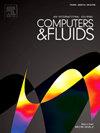Effects of two-dimensional reed oscillation on airflow and sound generation in a single-reed instrument
IF 2.5
3区 工程技术
Q3 COMPUTER SCIENCE, INTERDISCIPLINARY APPLICATIONS
引用次数: 0
Abstract
While two-dimensional (2D) reed oscillation modes of single-reed woodwind instruments have been reported in previous studies, little is known about their effects on airflow and sound generation. In this study, we conducted aeroacoustic simulations of a clarinet mouthpiece and resonator coupled with one-dimensional (1D) and 2D reed deformation models and investigated the changes in flow and sound generation due to the 2D reed vibration. The 1D and 2D reeds were modeled using 1D beam and thin plate theories, respectively, whereas the three-dimensional airflow was simulated by solving the compressible Navier–Stokes equations. The self-sustained oscillations of the 2D reed model mainly exhibited a flexural mode at the fundamental frequency, which is consistent with previous observations. Complex torsional modes were observed only at higher harmonic frequencies. A comparison between the 1D and 2D reed models demonstrated that the 2D reed opened later at the side face of the mouthpiece than the 1D reed owing to the torsional mode, which changed the time variation of the flow rate into the mouthpiece and the far-field sound in the high-frequency range. These results suggest the importance of the torsional deformation characteristics of reeds on the timbre of single-reed instruments.
二维哨片振荡对单簧乐器气流和发声的影响
尽管之前的研究已经报道了单簧木管乐器的二维(2D)哨片振荡模式,但对其对气流和发声的影响却知之甚少。在这项研究中,我们对单簧管吹嘴和共鸣器进行了气动声学模拟,并结合一维(1D)和二维簧片变形模型,研究了二维簧片振动对气流和声音产生的影响。一维和二维簧片分别使用一维梁和薄板理论建模,而三维气流则通过求解可压缩纳维-斯托克斯方程进行模拟。二维苇片模型的自持振荡主要表现为基频处的挠曲模式,这与之前的观察结果一致。只有在较高的谐波频率下才能观察到复杂的扭转模式。一维和二维哨片模型之间的比较表明,二维哨片在吹嘴侧面的打开时间晚于一维哨片,原因是扭转模式改变了吹嘴流量的时间变化和高频范围内的远场声。这些结果表明,哨片的扭转变形特性对单簧乐器的音色具有重要影响。
本文章由计算机程序翻译,如有差异,请以英文原文为准。
求助全文
约1分钟内获得全文
求助全文
来源期刊

Computers & Fluids
物理-计算机:跨学科应用
CiteScore
5.30
自引率
7.10%
发文量
242
审稿时长
10.8 months
期刊介绍:
Computers & Fluids is multidisciplinary. The term ''fluid'' is interpreted in the broadest sense. Hydro- and aerodynamics, high-speed and physical gas dynamics, turbulence and flow stability, multiphase flow, rheology, tribology and fluid-structure interaction are all of interest, provided that computer technique plays a significant role in the associated studies or design methodology.
 求助内容:
求助内容: 应助结果提醒方式:
应助结果提醒方式:


